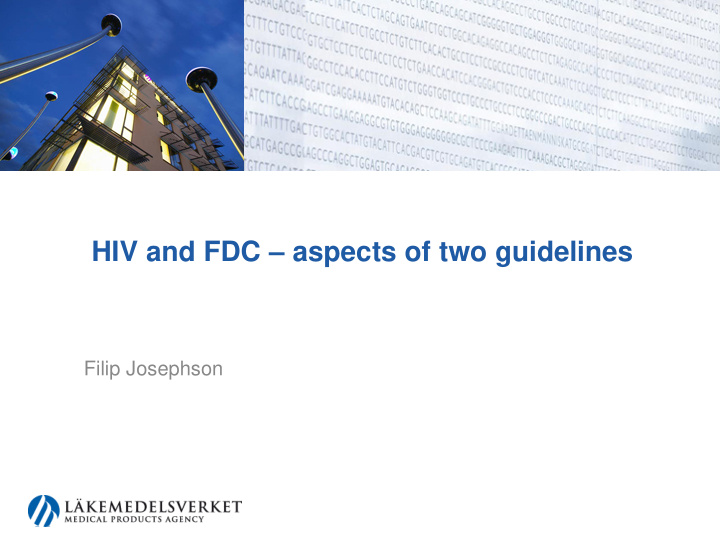



HIV and FDC – aspects of two guidelines Filip Josephson
Status • Ongoing process • Updated draft guideline for HIV drug development available for public consultation on EMA website since 2013 • Presently under revision subsequent to comment
Developments prompting the ongoing guideline revision • Treatment landscape changed ; approval of darunavir, raltegravir, etravirine • Development of multi-class resistance increasingly uncommon; most patients with virological failure have treatment options likely to be fully active • Difficult to show add-on effects in traditional superiority studies in treatment experienced patients • Non-inferiority studies in TE patients fraught with methodological problems
”Its the virus, stupid” David Ho, 1996 • Take into account the considerable available general understanding of antiretroviral PK/PD • View trial populations according to documented viral resistance rather than treatment histories per se. • Treatment naïve understood to mean “treatment naïve virus” - i.e. no relevant viral drug resistance • Treatment experienced no longer seen as crucial definition of study population; focus on virus with demonstrated resistance that is relevant to the class to which the new agent belongs
Standard drug development pathway (adults) • Two pivotal non-inferiority trials (48 week data) in previously untreated patients with fully antiretroviral-susceptible virus forms basis of safety and efficacy demonstration (as previously) 24-48 week (superiority or non-inferiority) study in ”treatment • experienced” patients no longer required/requested • Demonstration of activity against virus with drug resistance relevant to the class of the investigational agent proposed as basis for approval in patients whose virus have potentially reduced susceptibility to the test agent • Study randomises patients with failing regimen and relevant resistance to add on of test agent or placebo, with primary endpoint at 7-14 days; followed by 24-48 weeks ”uncontrolled” prospective cohort investigation of durability of response as a function of OBT activity.
Pediatric antiretroviral drug development • Updated guidance contains clarification rather than change of approach Dose selection is generally based on results from • pharmacokinetic studies, where doses for different age groups are selected to produce plasma levels similar to those observed in adults. Emphasis on the need for acceptable and palatable drug • formulations • “In many cases dose per weight band is an unambiguous way to express dose recommendations. If possible, the use of WHO weight bands should be considered.”
Focus on PK investigation, supported by PK/PD extrapolation As it is assumed that the PK/PD relation for a direct acting • antiviral is roughly similar regardless of the age of the patient, the efficacy of a dose that yields sufficiently similar exposure in children, compared to adults, would be inferred (bridging). • Therefore non-comparative data in children on the tolerability and safety of the proposed dose regimens as well as documentation of adherence should be generated over appropriate time-spans. • The extent of the required safety assessments should be based on available non-clinical and adult clinical data • If circumstances allow, PK as well as safety data may be generated in switch studies in virologically suppressed children
Fixed dose combinations (FDC) If the FDC includes a new anti-retroviral agent and/or a new • pharmacokinetic enhancer then a full clinical development programme for the new agent will be required. • If the FDC is to be used in the place of concomitant administration of agents in a regimen for which safety and efficacy are well-documented, the application may be based primarily on demonstrating bioequivalence for each agent when administered as the FDC vs. concomitant administration • For FDCs intended for use in children, special considerations are warranted as regards age/weight related differences in clearance or bioavailability of the individual components of the combination and the need for sufficient dose forms to accommodate dose adjustments.
Basic requirement for an FDC 1. Justification of the pharmacological and medical rationale for the combination. 2. Establishment of the evidence base for the: • a. relevant contribution of all active components to the desired therapeutic effect; • b. positive risk-benefit for the combination. 3. Verification that the evidence base presented is relevant to the product applied for (e.g., relevant bioequivalence studies to “build a bridge”)
Recommend
More recommend